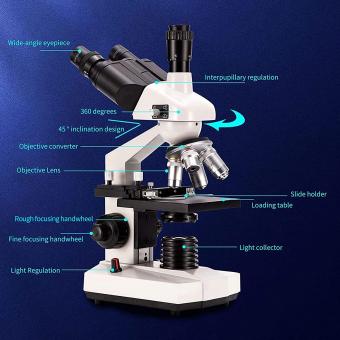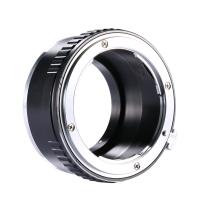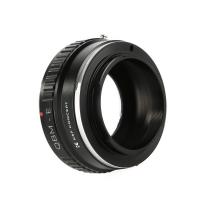What Is Condenser Microscope ?
A condenser microscope is a type of light microscope that uses a condenser lens to focus light onto the specimen being observed. The condenser lens is located beneath the stage and is used to concentrate the light from the microscope's light source onto the specimen. This results in a brighter and more focused image of the specimen.
The condenser lens can be adjusted to control the amount of light that is focused onto the specimen, which can be useful for improving the contrast and clarity of the image. Some condenser microscopes also have additional features, such as an iris diaphragm or a filter holder, that can be used to further adjust the amount and quality of light that is used to illuminate the specimen.
Condenser microscopes are commonly used in biological and medical research, as well as in materials science and other fields where high magnification and resolution are required. They are often used in conjunction with other types of microscopes, such as phase contrast or fluorescence microscopes, to provide a more complete picture of the specimen being studied.
1、 Definition and basic principles of condenser microscopy

What is condenser microscope?
A condenser microscope is a type of optical microscope that uses a condenser lens to focus light onto the specimen being observed. The condenser lens is located beneath the stage and is used to concentrate the light from the microscope's light source onto the specimen. This results in a brighter and more detailed image of the specimen.
The basic principles of condenser microscopy involve the use of a condenser lens to focus light onto the specimen, which is then magnified by the objective lens. The condenser lens is adjustable, allowing the user to control the amount of light that is focused onto the specimen. This is important because too much light can cause the specimen to become overexposed, while too little light can result in a dim image.
In addition to the condenser lens, a condenser microscope also typically includes an iris diaphragm, which is used to adjust the size of the aperture through which light passes. This allows the user to control the amount of light that reaches the specimen, further enhancing the clarity and detail of the image.
The latest point of view on condenser microscopy is that it remains an important tool in the field of microscopy, particularly for observing small and delicate specimens. However, advances in technology have led to the development of other types of microscopes, such as confocal and electron microscopes, which offer even higher levels of magnification and resolution. Nonetheless, the condenser microscope remains a valuable tool for researchers and scientists in a variety of fields.
2、 Types of condenser microscopes and their applications

What is condenser microscope?
A condenser microscope is a type of microscope that uses a condenser lens to focus light onto the specimen being observed. The condenser lens is located beneath the stage and is used to concentrate the light onto the specimen, making it easier to see and study. This type of microscope is commonly used in biology, medicine, and other scientific fields.
Types of condenser microscopes and their applications:
There are several types of condenser microscopes, each with its own unique features and applications. One type is the brightfield microscope, which is commonly used in biology and medicine to observe stained specimens. Another type is the phase contrast microscope, which is used to observe living cells and other transparent specimens. The darkfield microscope is another type of condenser microscope that is used to observe specimens that are difficult to see with other types of microscopes.
In recent years, advances in technology have led to the development of new types of condenser microscopes, such as the confocal microscope and the super-resolution microscope. These microscopes use advanced imaging techniques to provide higher resolution and more detailed images of specimens.
Overall, condenser microscopes are an important tool in scientific research and are used in a wide range of applications, from studying the structure of cells to developing new medical treatments. As technology continues to advance, it is likely that new types of condenser microscopes will be developed, further expanding our ability to observe and study the microscopic world.
3、 Components of a condenser microscope and their functions

What is a condenser microscope?
A condenser microscope is a type of light microscope that uses a condenser lens to focus light onto the specimen being observed. This type of microscope is commonly used in biological research and medical laboratories.
Components of a condenser microscope and their functions:
1. Condenser lens: The condenser lens is the most important component of a condenser microscope. It is responsible for focusing the light onto the specimen being observed. The condenser lens is located beneath the stage and can be adjusted to control the amount of light that passes through the specimen.
2. Iris diaphragm: The iris diaphragm is located within the condenser lens and controls the size of the aperture through which light passes. By adjusting the iris diaphragm, the user can control the amount of light that reaches the specimen.
3. Stage: The stage is the platform on which the specimen is placed for observation. It is usually equipped with clips or other mechanisms to hold the specimen in place.
4. Objective lens: The objective lens is located above the stage and is responsible for magnifying the image of the specimen. Condenser microscopes typically have multiple objective lenses with different magnification levels.
5. Eyepiece: The eyepiece is located at the top of the microscope and is used to view the magnified image of the specimen. It typically has a magnification level of 10x.
In addition to these components, some condenser microscopes may also have a filter holder, which allows the user to insert filters to adjust the color or contrast of the image.
Overall, the condenser microscope is a powerful tool for observing and studying biological specimens. With its precise focusing and magnification capabilities, it has become an essential tool in many scientific fields.
4、 Techniques for optimizing condenser microscope performance

What is condenser microscope?
A condenser microscope is a type of microscope that uses a condenser lens to focus light onto the specimen being observed. The condenser lens is located beneath the stage and is used to concentrate the light from the microscope's light source onto the specimen. This results in a brighter and more detailed image of the specimen.
Techniques for optimizing condenser microscope performance:
There are several techniques that can be used to optimize the performance of a condenser microscope. One of the most important is to ensure that the condenser lens is properly aligned with the microscope's objective lens. This can be done by adjusting the height and position of the condenser lens until the image is clear and sharp.
Another technique is to adjust the aperture of the condenser lens. This can be done by opening or closing the iris diaphragm, which controls the amount of light that passes through the condenser lens. By adjusting the aperture, the user can control the amount of light that reaches the specimen, which can improve the contrast and clarity of the image.
In addition, it is important to use the correct type of illumination for the specimen being observed. For example, some specimens may require brightfield illumination, while others may require darkfield or phase contrast illumination. By using the correct type of illumination, the user can improve the visibility of the specimen and obtain a clearer image.
The latest point of view on optimizing condenser microscope performance is the use of digital imaging technology. Digital cameras can be attached to the microscope to capture high-resolution images of the specimen. These images can then be analyzed and manipulated using specialized software, which can provide additional information about the specimen and improve the accuracy of the analysis.






























There are no comments for this blog.